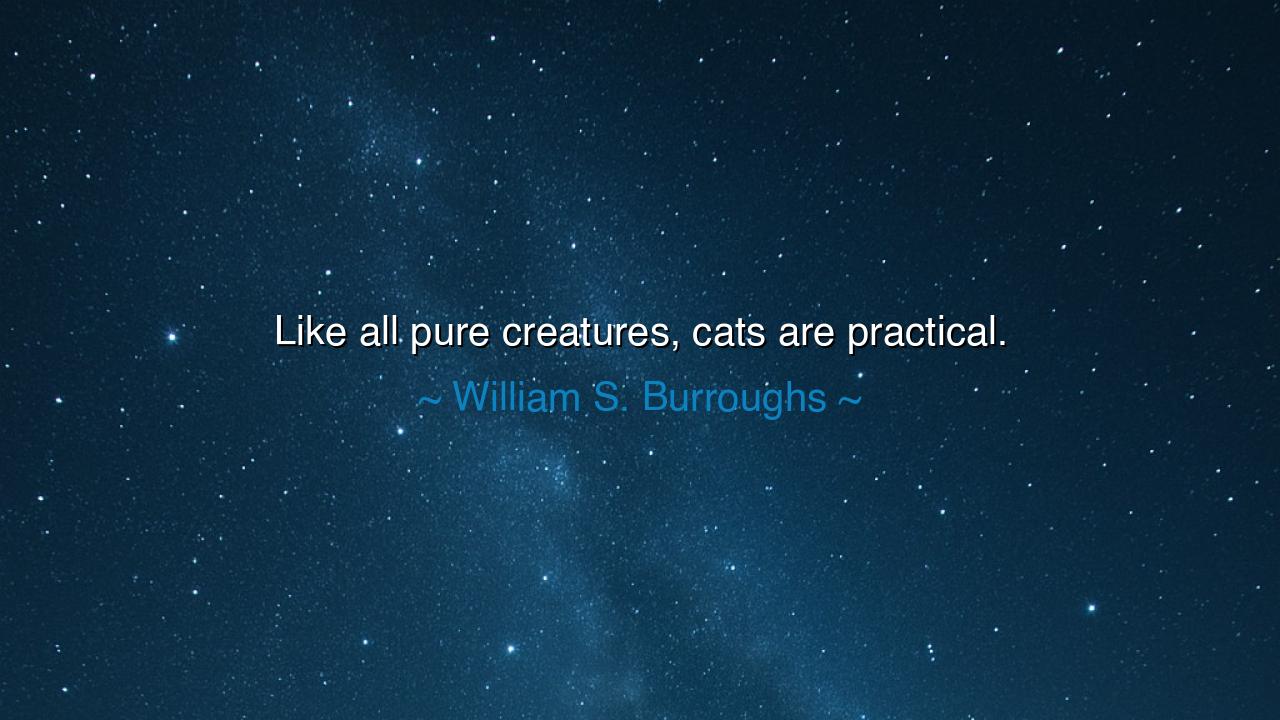
Like all pure creatures, cats are practical.






Hear the sharp yet tender words of William S. Burroughs: “Like all pure creatures, cats are practical.” Though brief, these words carry the weight of paradox and insight. What does it mean to call a being both pure and practical? To the unseeing eye, purity seems delicate, fragile, even naive. Practicality, in contrast, appears worldly, measured, and often hardened by necessity. Yet Burroughs binds them together in the image of the cat, showing us that true purity is not weakness—it is wisdom refined into simplicity.
The cat is a creature of instinct, yet never wasteful. It does not hunt for glory, but for need. It does not lavish energy upon empty pursuits, but saves its strength for decisive action. This is the essence of practicality: to move with precision, to preserve, to act only when the moment is right. And in this, the cat is also pure, for it does not deceive itself with vanity or ambition. It is wholly aligned with the rhythm of its own nature. Humanity, in contrast, often confuses waste with greatness, and indulgence with joy. The cat shows us a better way.
Let us recall the story of Diogenes the Cynic, the philosopher who sought truth through simplicity. He rejected the excesses of Athens and lived in a clay jar, saying he had no need for luxury. When Alexander the Great offered to grant him any wish, Diogenes simply replied, “Stand out of my sunlight.” Like the cat, he lived with practical wisdom, uncorrupted by false desire. His purity lay in his freedom from the chains of excess. His practicality lay in knowing that happiness is found not in abundance, but in alignment with nature.
Burroughs, a man who wrestled with the shadows of modern life, saw in cats a mirror of what mankind has lost. They are pure creatures because they do not war against themselves. They accept hunger when it comes, rest when they must, and leap when the chance arrives. They do not squander the gift of life in endless worry or regret. Their practicality is not cold calculation, but harmony—the art of living fully within one’s means and one’s truth.
How often do humans complicate what is simple! We toil after wealth to buy what we do not need. We chase recognition to soothe egos never satisfied. We scatter our energies into a thousand directions and wonder why peace evades us. Yet the cat, stretched lazily in the sun or crouched silently at the hunt, teaches that to live purely is to live with clarity: to do what must be done, and to discard what weighs down the spirit.
The lesson is clear: purity and practicality are not opposites, but companions. To be pure is not to live apart from the world, but to move within it without waste or falsehood. To be practical is not to be cynical, but to be wise enough to let go of what is needless. The cat embodies this balance without effort. For man, the path requires intention, yet it is no less attainable.
What, then, must we do? Begin by discerning what is necessary from what is vanity. Ask yourself: does this labor, this desire, this burden serve my true life? If not, release it. Practice simplicity in action and clarity in thought. Rest when weary, work with focus, speak with truth. Let the cat be your silent teacher: live with grace, live with purpose, live without waste.
Thus, let Burroughs’ words echo across the ages: “Like all pure creatures, cats are practical.” The cat’s lesson is not for itself, but for us—that purity is found not in retreat from the world, but in meeting it with unclouded instinct, balanced action, and serene contentment. Follow this teaching, and your days will be lighter, your actions sharper, and your spirit unburdened, as practical and pure as the quiet wisdom of the cat.






AAdministratorAdministrator
Welcome, honored guests. Please leave a comment, we will respond soon